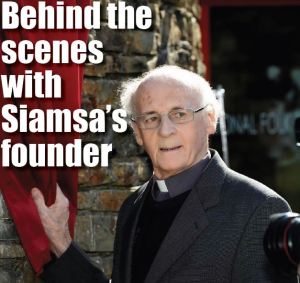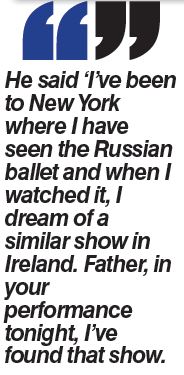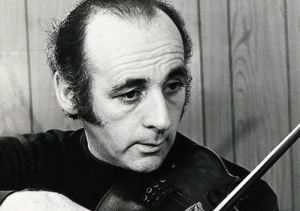 Fergus Dennehy talks to North Kerry’s Fr Pat Aherne, a man credited with revitalising the traditional music and dance scene in both Kerry and Ireland, when he founded the famous Siamsa Tíre. Here, he talks to us about growing up in a different time, how Siamsa Tíre came about and his fondest memories from a truly incredible life.
Fergus Dennehy talks to North Kerry’s Fr Pat Aherne, a man credited with revitalising the traditional music and dance scene in both Kerry and Ireland, when he founded the famous Siamsa Tíre. Here, he talks to us about growing up in a different time, how Siamsa Tíre came about and his fondest memories from a truly incredible life.
FOR those of us of the untrained eye, there have no doubt been times when our eyes have passed over the charming and familiar stone brick exterior of Siamsa Tíre and not given a moments thought to the incredible story and history hidden inside its hallowed vaults of knowledge.
As a Tralee native and someone who has too often been guilty of the above crime of ignorance, I was on a quest to right this wrong and where bettter to start than sitting in the living room of its now 85-year-old founder, Father Pat Aherne.
A Moyvane native, Father Aherne grew up surrounded by music – his mother and brother Seán were talented fiddle players and singers respectively – and he says that if there is anything that growing up in the 30’s and 40’s, surrounded by music, singing, dancing and working on the farm taught him, it is the importance of tradition.
In the context of Siamsa Tíre and its founding then, it is this sense of the importance of tradition that he holds that was to become ‘the seed’ for what would eventually grow into Siamsa Tíre.
Fr Aherne was first sent to Tralee as a young curate back in 1957 where he was tasked with setting up a new choir in Tralee – a task that he still remembers fondly to this day and one which he took to with relish.
“Back then in 1957, there was very little happening with regards to music in town and because of this, without the choir, a lot of the people who joined who never have had another outlet to learn music,” said Fr Aherne, talking on Thursday.
 “It [setting up the choir] was a nice challenge for a young fella like myself but you have to remember, in those days, almost everything was in Latin, including the music!”
“It [setting up the choir] was a nice challenge for a young fella like myself but you have to remember, in those days, almost everything was in Latin, including the music!”
“A lot of the lads and ladies who joined originally, they wouldn’t have had it at all. That made the task of learning the music that little bit trickier for them,
“The choir just took off though, it was initially just boys and men – it was called St John’s Gregorian Choir. We had great times back then – we were all young and energetic and we worked hard. Everyone there learned to read music and these were people who would never have studied any bit of music, it was wonderful.”
The initial success of the choir led to them being asked to perform a short pageant to celebrate the centenary of the Lourdes apparitions, a pageant which the group called Massabielle and which was performed in the old CYMS hall in Tralee [now the KDYS].
This successful first outing was to prove to be a major stepping stone for Fr Aherne and his choir.
“Thanks to Massabielle and its success, this then led us on to do a more ambitious show later in 1963, the Passion Play in Tralee about the life of Christ. It went for a long run in the CYMS Hall.”
Again this performance by Fr Aherne’s choir was met with such acclaim that Dean Donal Reidy organised a special celebratory performance night in what was then the Manhattan Hotel [now Ballygarry House Hotel].
It was to be a performance that would serve as the impetus for the future Siamsa Tíre performances.
“I put on a little cabaret there, using the singers, dancers and musicians and it was went very well – it just skyrocketed and we
decided then and there that we wanted to do more things. This was then the little seed that started it all off for us,” he continued.
The rest, as they say is history. What followed was a period of great success both nationally and internationally for the group, which in 1974, was officially renamed as the Siamsa Tíre that we know today, woith its founder Fr Ahernem being named as Artistic Director, a position that he held until his retirement in 1998.
While he’s the first to admit that there has been too many good memories over the years to definitively pick out a favourite, he said that it was the words of a man called Brendan Regan that stand out as one of his proudest moments.
 “We were doing a week in the Abbey Theatre in Dublin and a man came backstage to see us after the show and this man was Brendan O’ Regan. He was a big, big name at the time, a visionary if you like. He was the man who founded the Shannon Free Airport Development and he was the chairman of Bord Fáilte aswell,” said Father Aherne, taking another sip of tea, his foot stretched out, relaxing on the chair in front of him.
“We were doing a week in the Abbey Theatre in Dublin and a man came backstage to see us after the show and this man was Brendan O’ Regan. He was a big, big name at the time, a visionary if you like. He was the man who founded the Shannon Free Airport Development and he was the chairman of Bord Fáilte aswell,” said Father Aherne, taking another sip of tea, his foot stretched out, relaxing on the chair in front of him.
“He said ‘I’ve been to New York, where I have seen the Russian ballet and when I watched it, I dreamt of a similiar show in Ireland. Father, in your performance tonight, I’ve found that show.’ He was a man of clout and he said that we had to get all of this on a firm footing – this was not just an amazing appreciative moment of all of our hard work, this was the beginning of Siamsa Tíre. It was an excellent thing for us to hear, from someone so revered,” he continued.
A tour of America was to follow for Fr Aherne and his merry band of singers, musicians and dancers and for some of the group, a lot of whom were leaving Ireland for the first ever time, finding themselves in cities such as New York, Boston and Chicago was a magical, magical experience.
“I’ll always remember one man, Gerry Nolan, he was out of my own parish in Moyvane. He was a beautiful, beautiful step dancer and of course, he had never been out of the country and this man from Moyvane brought down the house in every city we went to!”
“It was amazing, the reaction to his performances. He was a simple and quiet man you know? Going to New York to him was the same as going to Dublin. Here we were in Broadway then, performing in the home of theatre and performance and he went out and the audience, they just clapped and clapped and clapped and even when he came off the stage, they were still clapping and he just turned to the fella next to him and says ‘jaysus, they must know me!’” Fr Aherne says, letting out a chuckle at the memory of his friend.
It was the success of this tour, Fr Aherne said, that gave great creedence to the idea of using Irish folklore and music and dance as a performance art an again cemented the need for Siamsa Tíre.
One man whose core message and style still permeates through Kerry today was a travelling dace teacher called Jeremiah Moly- neaux, or ‘Munnix’ as Fr Aherne affectionately calls him.
Munnix was a man, that Fr Aherne credits with not just helping to bring through some of Siamsa’s most talented dancers, the supremely gifted Jimmy Smith being one of these, but also a man who first ‘wowed’ a young Fr Aherne into wanting to learn to dance.
“He was a beautiful, beautiful dancer. I had met when I was in school in Moyvane and he came to teach in the school. He said, ‘anyone who’s interested in dancing, head into the hall there’.”
“He went out on the floor and danced the hornpipe and my god, I’ll never forget it, the impact it had on me. What this man could do with his two feet, it was absolutely phenomenal, I’d never seen anything like it. It was amazing.”
Finally and fittingly, a man always with a sense of tradition at the back of his mind, Father Aherne, between sips of tea and an odd biscuit or two, tells me of how importantly he viewed the Irish language and all of the old stories and poems hidden within it in helping shape Siamsa’s work.
“The Irish language is one that enshrines all of our best traditions. Irish is the repository of all of our most important traditions. If you want to know the midset of a people, you must first understand the language,” he finished.
Traditional to the last.
